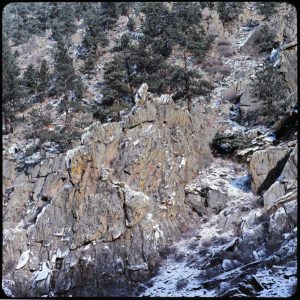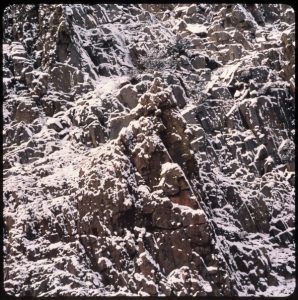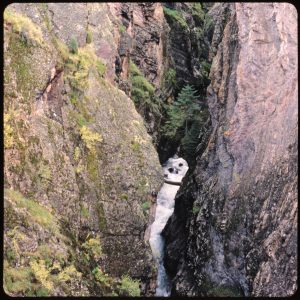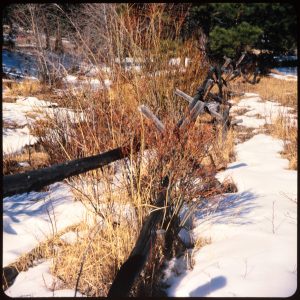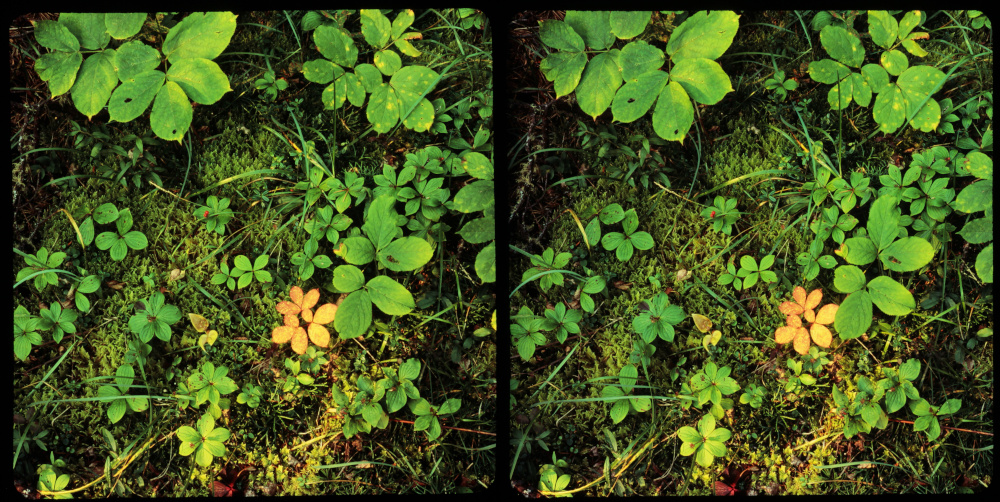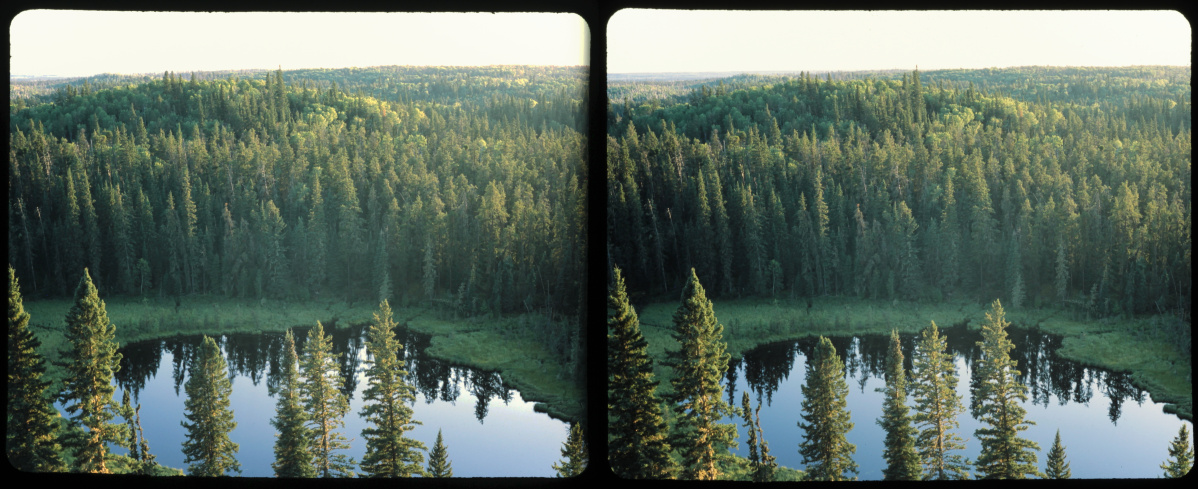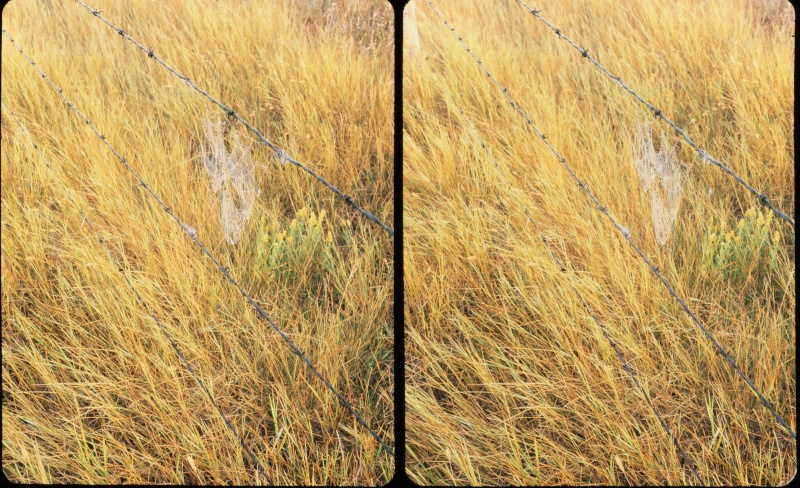This is a page to leave comments on Joel’s slides for loop D23.
Bridges
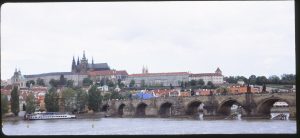 Charles Bridge Hyper
Charles Bridge Hyper
This is the famous Charles Bridge(Karluv Most) in Prague. I have photographed this bridge from many angles, finally in hyper.
This was shot with my Lubitel rig, although this one was done cha-cha style. It is on Provia f100 film, but shutter speed, aperture and stereo base are long forgotten. This slide was a challenge to mount, but had I cropped it a bit more, I probably could have saved some serious frustration.
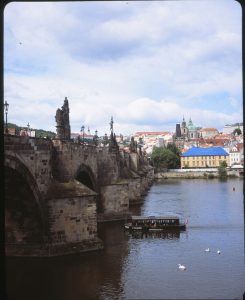
Charles Bridge Prague
Another hyper shot of Charles Bridge (Karluv Most), probably on the same day, from my Lubitel rig. My bar maxes out at about 18″ which this could be.
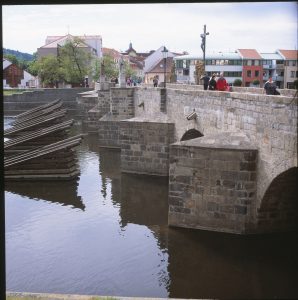 Stag Bridge in Pisek, South Bohemia.
Stag Bridge in Pisek, South Bohemia.
This bridge is older (late 13th century) than Charles Bridge in Prague (early 15th century), but built in the same style. The river Otava, which it spans, flows into the Vltava river, so a riverboat traveling downstream will arrive quickly in Prague to pass under the younger cousin Charles Bridge.
TL120 on Provia f100 film
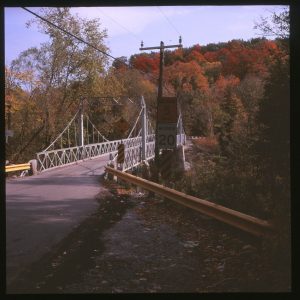 Rural Scarborough Suspension Bridge
Rural Scarborough Suspension Bridge
Keeping with the bridge theme I decided to include this image from last fall. It was intended as a fall colour shot but I decided to also include this rural bridge in suburban Scarborough (a suburb of Toronto). This area is difficult to develop, so while it is only a short distance from the ever expanding subdivisions, I hope this quaint bridge carries on for a long time. There are two other, similar bridges nearby, one of which is 15 seconds drive up the road.
Shot with my TL120 on Provia f100
Christmas in Ginza Tokyo

I shot this in 2004 using a twin Yashica-Mat 124 rig. I would go on these business trips to Japan with just a few items of clothing and my suitcase filled with tripods, twin bars and other camera gear. I brought the actual cameras as carry-ons whenever possible. They’d keep me working all day so I ended up with lots of nighttime shots.
This was probably a two second exposure at f16, I manually fired a Vivitar 285H flash while the shutter was open.
Rita N Wink on the mic
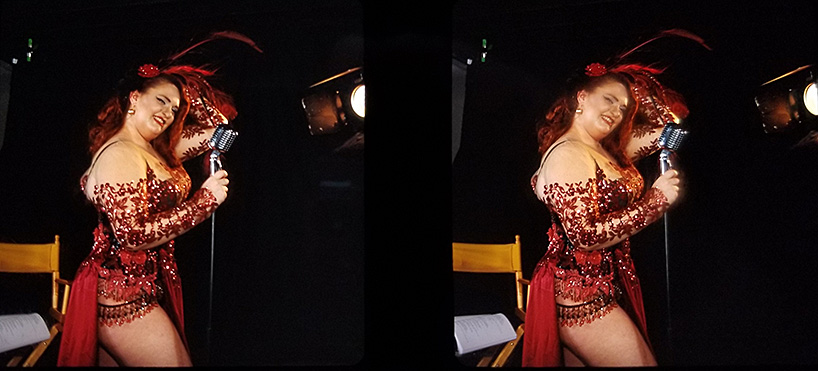
From a 2018 New York Pinup Club shoot – TL120 with a Vivitar 285H flash. There was also some studio lighting, I used an incident meter and crossed fingers. I was using long exposures, 1/4 or 1/2 second and asking the models to hold still.
San Francisco Playground

This was taken with twin Mamiya C220s using 135mm lenses. Provia 100F pushed one stop. I love the surreal effect of slightly hyper telephoto shots, San Francisco offers lots of nice elevated views where this works well.
Katie Kells Beach-Ball
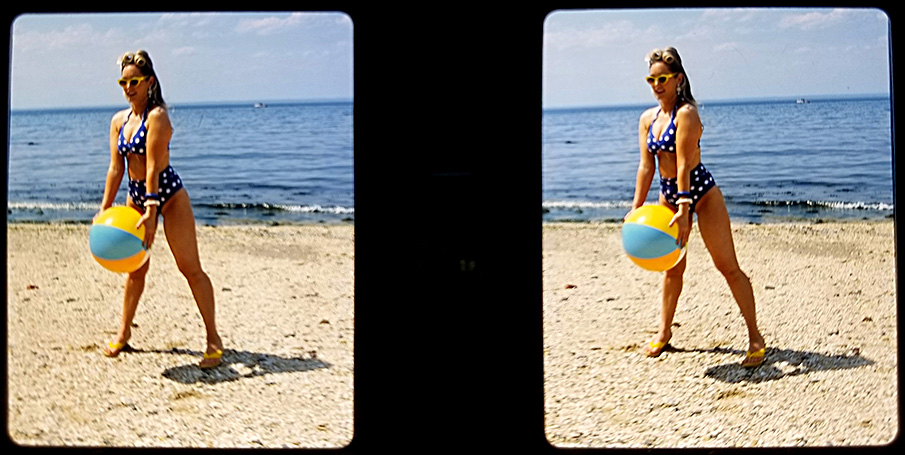
This is from a New York Pinup Club shoot in Long Island June 2021. It was very hot and humid that day, many of the photographers went home early. This is a TL-120 without a flash, Provia 100F pushed one stop. I believe it was 1/125 at f22.
Cooper Lake, Cle Elum, Washington
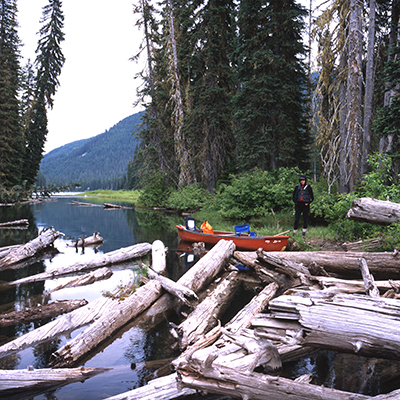 Travel has been a bit hard to do recently, out of the country at least. As you all know there’s a bit of a ‘stay-cation’ happening for most of us. Due to this fact, I have decided to share some of my more recent camping experiences that we have taken within Washington state, and with my newly acquired 3D World TL-120 camera (bought in 2020). This particular lake you see here is one of my favorite spots in Washington. It’s a small lake, but big enough to paddle around and explore. Only paddle boats are allowed which makes it nice and quiet at times and the camping is inexpensive. This shot was taken towards the Northwest side of the lake, just a little ways into Cooper River, which feeds into the lake. Since the lake is river fed from far off mountains, it gets pretty cold but is also nice and clear. I managed to scramble over the log jag to get this shot of my fiancee and our canoe named ‘Downeaster Alexa’. Both of them accompany me in many camping excursions that we all love to take. My personal critique would say, ‘get low to see more water and logs in the foreground’. But, other than that, I think it works ok.
Travel has been a bit hard to do recently, out of the country at least. As you all know there’s a bit of a ‘stay-cation’ happening for most of us. Due to this fact, I have decided to share some of my more recent camping experiences that we have taken within Washington state, and with my newly acquired 3D World TL-120 camera (bought in 2020). This particular lake you see here is one of my favorite spots in Washington. It’s a small lake, but big enough to paddle around and explore. Only paddle boats are allowed which makes it nice and quiet at times and the camping is inexpensive. This shot was taken towards the Northwest side of the lake, just a little ways into Cooper River, which feeds into the lake. Since the lake is river fed from far off mountains, it gets pretty cold but is also nice and clear. I managed to scramble over the log jag to get this shot of my fiancee and our canoe named ‘Downeaster Alexa’. Both of them accompany me in many camping excursions that we all love to take. My personal critique would say, ‘get low to see more water and logs in the foreground’. But, other than that, I think it works ok.
As I mentioned, this was shot on my new TL-120 camera (1st generation), using good old Fuji Provia 100f film.
Hoh Rainforest, Olympic National Park, Washington
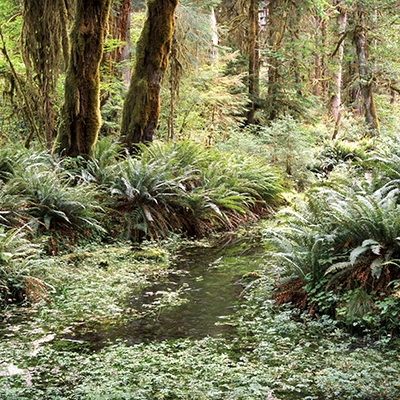 The Hoh Rainforest is one of the wettest places in all of the continental United States, and has been on my bucket list for years after moving to Washington. The Hoh Rainforest wasn’t dry per se, but it was definitely experiencing a drought, much like most of the west this year. The rangers had posted that it had received 5-7 inches less rain than previous years. It’s a bit of a drive to get here (although one of the prettiest I have ever driven), and it can become a crowded experience, especially during a weekend. However, it was still great to visit and a wonderful spot to see. Hopefully it will survive the implications of climate change, because it’s a gorgeous place in the world. This was taken towards the end of the Spruce Nature Trail. It was definitely one of the highlights within our visit of Olympic National Park. My inner critique would be, get low and get close (again)!
The Hoh Rainforest is one of the wettest places in all of the continental United States, and has been on my bucket list for years after moving to Washington. The Hoh Rainforest wasn’t dry per se, but it was definitely experiencing a drought, much like most of the west this year. The rangers had posted that it had received 5-7 inches less rain than previous years. It’s a bit of a drive to get here (although one of the prettiest I have ever driven), and it can become a crowded experience, especially during a weekend. However, it was still great to visit and a wonderful spot to see. Hopefully it will survive the implications of climate change, because it’s a gorgeous place in the world. This was taken towards the end of the Spruce Nature Trail. It was definitely one of the highlights within our visit of Olympic National Park. My inner critique would be, get low and get close (again)!
Taken with my 3D World TL-120, and again with Fuji Provia 100f film.
Douglas Fir Campground, Mt. Baker Wilderness, Washington
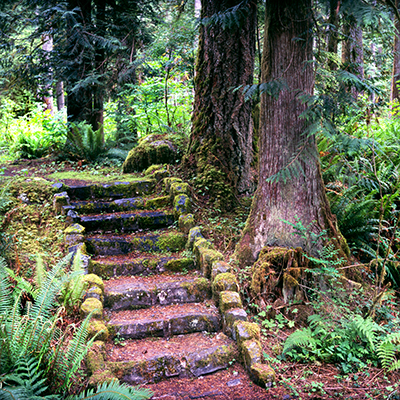 This campground is great if you are ever up near the North Cascades and near Mt. Baker, another active volcano in Washington. It features tall Douglas Fir trees and is great to stop off at before heading into Canada. Upon walking around the campground (RV and car camping mind you), we came across these stone steps. The lighting was pretty nice, so I took a few shots. All in all, it came out ok IMHO. However, in hindsight, I would have liked to get a little closer and get more detail in the shot. Since I have moved to using the TL-120 from having used a Sputnik for years, I find myself shooting from further away. However, after looking at other pics in the folio, it seems to me that some of you are shooting closer than I had ever thought I could with the TL-120. So, we’ll see how I can make up for that in the future. Wish me luck!
This campground is great if you are ever up near the North Cascades and near Mt. Baker, another active volcano in Washington. It features tall Douglas Fir trees and is great to stop off at before heading into Canada. Upon walking around the campground (RV and car camping mind you), we came across these stone steps. The lighting was pretty nice, so I took a few shots. All in all, it came out ok IMHO. However, in hindsight, I would have liked to get a little closer and get more detail in the shot. Since I have moved to using the TL-120 from having used a Sputnik for years, I find myself shooting from further away. However, after looking at other pics in the folio, it seems to me that some of you are shooting closer than I had ever thought I could with the TL-120. So, we’ll see how I can make up for that in the future. Wish me luck!
Shot on my new TL-120 with old expired Fuji Velvia 100f film. Hence the subtle magenta cast.
Diablo Lake, North Cascades National Park, Washington
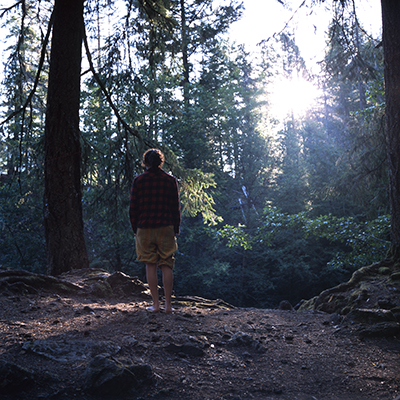 This was taken at one of my favorite campsites in all of Washington. It’s by far, one of the prettiest and most secluded sites on Diablo Lake. It features a lookout, swimming hole, a bear box, and even an outhouse! Not to mention access to the serenity of the lake and it’s wonderful turquoise glacier fed water. Now, this shot could easily have NOT been taken near any lake, since you can’t see any water. However, it was one of my favorite shots on this roll of film, and was taken spontaneously. The lighting was amazing, and definitely inspired me to take a shot. Diablo Lake campsites are on a ‘lottery reservation’ system through the National Park service and reservations are especially needed for this spot on the lake. The North Cascades are wonderful to visit, and I highly recommend coming here if you are ever in Washington. My personal critique would be, maybe get a little closer, and show some of the lake! Other than that, it was a moment of time that I was happy to capture, especially in 3D!
This was taken at one of my favorite campsites in all of Washington. It’s by far, one of the prettiest and most secluded sites on Diablo Lake. It features a lookout, swimming hole, a bear box, and even an outhouse! Not to mention access to the serenity of the lake and it’s wonderful turquoise glacier fed water. Now, this shot could easily have NOT been taken near any lake, since you can’t see any water. However, it was one of my favorite shots on this roll of film, and was taken spontaneously. The lighting was amazing, and definitely inspired me to take a shot. Diablo Lake campsites are on a ‘lottery reservation’ system through the National Park service and reservations are especially needed for this spot on the lake. The North Cascades are wonderful to visit, and I highly recommend coming here if you are ever in Washington. My personal critique would be, maybe get a little closer, and show some of the lake! Other than that, it was a moment of time that I was happy to capture, especially in 3D!
Shot also on my 3D World Tl-120 camera, with Fuji Provia 100f film.
Ian Andvaag A32 submission
Two of my contributions to this loop, Boreal Floor and From the Esker were taken at Narrow Hills Provincial Park in northern Saskatchewan. The latter was taken from an esker (ridge of earth pushed up by the last glacier) that runs along the park. It provides a nice vantage point looking over the boreal forest and numerous small lakes. Here I attempted a hyper stereo with my TL-120 by covering one lens and moving the tripod about a metre between exposures. There was a significant amount of smoke from wildfires in the area when I last visited the park, so unfortunately the sky was washed out and featureless in all of my slides.
The other two images were taken at Grasslands National Park very near the Saskatchewan-Montana border. Crested Wheat Corral is in the west block of the park where the remains of several small ranches can be found. The area is very arid, and ranchers tried tilling the soil to improve the pasture, but this turned out to be a poor practice. They introduced Crested Wheatgrass (native to Russia) to the disturbed soil with limited success, but it did prevent further erosion. Large portions of the park still contains undisturbed virgin prairie, which is probably one of the most disturbed landscape types on the globe due to its agricultural usefulness. It’s somewhat off-topic for MF3D, but I made a surprisingly successful silver gelatin print from this slide by making an internegative. I think that this approach yields much better results than a direct reversal print.
Bee Good #4
This whole set could be titled “Adventures Near and Far.”
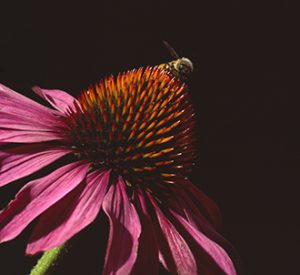
Bee Good #4
This was shot in August of 2020. Lots of the technical details are listed on the slide mount. One detail is listed incorrectly—the extension is 56mm and not 57. Cameras were triggered with the same wired trigger that I’ve used for fireworks. I like the look of the stamen in this shot—each one looks like a nuclear warhead. Using the macrobox, I was able to get a shot like this as well as shots of my cat Edison that circulated last round. But a total PITA to set up and use.
Meanwhile, a new friend of mine had opened my eyes to some Hasselblad equipment I was unaware of— things like bodies with built-in motor drives and wired remotes. I picked up a couple of the motorized bodies, but they were too big for the macrobox. That’s when the quest for a new macrobox began in earnest. By the end of September I had ordered an optical breadboard from Baselab Tools, which was to be the platform for my new toy.
Orchid #3
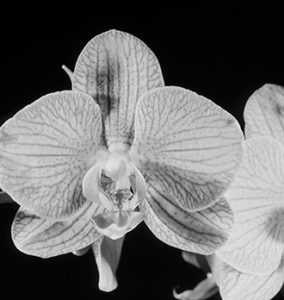
DR5 Orchid
Takin’ It to ‘Z!’
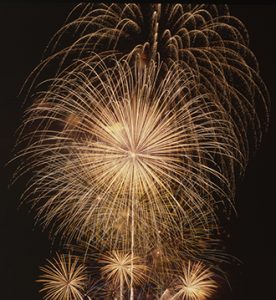
Takin’ It To ‘Z!’
F32 and BEE There!
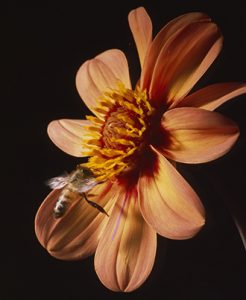
F32 and BEE There!
